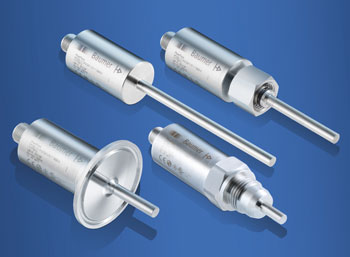Calorimetric flow and temperature sensors
Baumer proposes its flow sensors for hygienic applications and industrial use. These solutions are based on the calorimetric measurement principle and can monitor flow speed as well as media temperature
di Laura Di Jorio
Optimizing processes is always worthwhile, both for the environment and for the wallet of the system operator. This applies to cleaning processes in the hygiene-sensitive pharmaceutical and food areas as well as for cooling circuits in industrial manufacturing plants. Before processes and the use of the media can be improved, however, the first thing to record is the current state. In cooling or cleaning cycles, the flow rate and temperature should be known, preferably in both the forward and return flows. Sensors which work according to the calorimetric principle are a practical solution here, because the compact flow sensors indicate temperature at the same time. This reduces the number of measuring points and minimizes the effort required for installation, service and storage. The calorimetric measurement principle is based on the physical laws of thermal conduction and thermal transfer in liquids and gases. A body with a higher temperature releases energy into its environment in the form of heat.
The amount of this energy release depends on the temperature difference and the mass flow rate. This can be used in measuring technology: a heated sensor is cooled by the liquid flowing around it, and the degree of cooling is directly dependent on the mass flowing past it. In addition to the flow rate, the media temperature can also be recorded and monitored with one sensor. In principle, this method is suitable for all media and is independent of viscosity and electrical conductivity.
Sensors for industrial and hygiene applications
With FlexFlow PF20H and PF20S flow sensors, two calorimetric sensor types now supplement Baumer’s product portfolio, thus covering all common process variables. They can be used to record flow speeds and temperatures in various industries and processes. In the PF20S version, the thermal flow sensor meets all industrial requirements, while the PF20H version is designed specifically for use in hygienically sensitive areas. Both variants are suitable for flow speeds of 10 to 400 cm/s and temperatures of between -25 and +150°C. Therefore, they suffer no damage when, for example, CIP cleaning processes are carried out at high temperatures in the food or pharmaceutical industries. The sensors are available either as analog versions (4…20 mA, 0…10 V) or with user-adjustable outputs using IO-Link. The IO-Link interface makes it possible to configure several sensors simultaneously. This simplifies switching point adjustment for different process stages and saves time. All data sets can also be kept centrally in the PLC, ensuring error-free configuration of the system.
Monitoring cleaning cycles in the food and pharmaceutical sectors
Applications for thermal flow sensors are wide-ranging. With their help, for example, a wide range of different processes in closed pipe systems can be effectively monitored. CIP cleaning procedures in the food and pharmaceutical sectors are typical examples. Besides the temperature, the flow speed of the cleaning solution is an important criterion here. If it is too low, the cleaning takes too long and the productivity of the plant decreases. At worst, the cleaning quality may even suffer. Therefore it is recommended that flow speed be monitored not only immediately after the pump but also in the return flow. This provides a reliable indication of flow resistance in the pipes. It can be guaranteed that flow speed is sufficiently high for cleaning purposes even at the point furthest away from the pump. FlexFlow is ideal for such applications. Thanks to its symmetrical, centered design, the sensor can be optimally installed in the process regardless of installation position and orientation. This guarantees precise measurements and process safety. The systemic weakness typical of flow sensors (distinction between changes in temperature and changes in flow) with large jumps in temperature is now a thing of the past. A quality bit integrated in the IO-Link sensor variant indicates whether the flow signal is valid. However, FlexFlow flow sensors also have advantages in other cleaning processes. The monitoring of cleaning processes is recommended for both ecological and economic reasons, for example in bottle, textile or component part cleaning. If temperatures and flow speeds are monitored, the media can be used with fewer resources, the use of energy can be reduced and cleaning cycles can be optimized.
When temperature affects process quality
In many applications, the correct tool temperature is decisive for material properties or compliance with certain manufacturing tolerances and thus production success. FlexFlow flow sensors installed in either cooling circuits or temperature control devices monitor pre-defined process parameters reliably and safely. Thermal flow sensors can be easily installed in virtually any process, even in the steel industry, for example. They are available with different process connections and rod lengths from 16 to 200 mm. A sliding version is also available for the industrial sector; different nominal widths can then be covered with the same sensor. Since thermal flow sensors have no moving mechanical parts, they are virtually maintenance-free.

